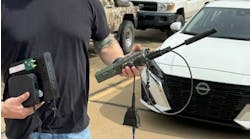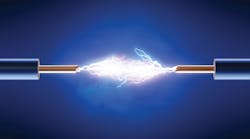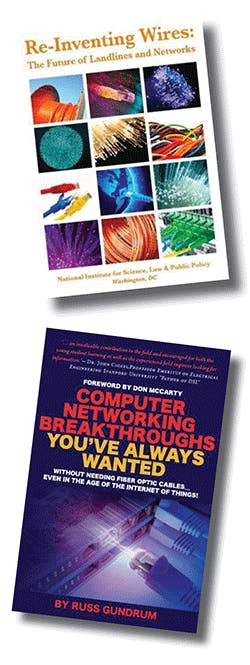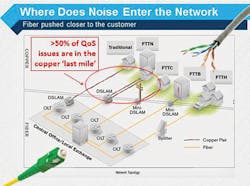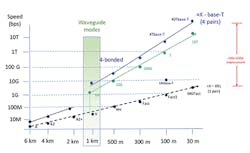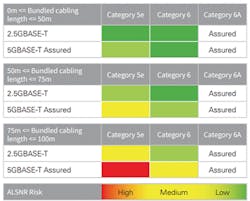Latest from Core/Legacy
Why Copper’s Lifetime May Be Longer Than Originally Thought —
Hang on to your hats and digest this! The original network infrastructure that was designed for voice communications over a hundred years ago is still just as resilient and viable a transmission medium for the high bandwidth data circuits of the 21st Century.
I may be one of the few people who remain concerned about copper facilities, because most people are either talking about 5G cellular and/or fiber, and very few seem to care about the wireline world anymore. I’m certainly not against either of these great networking technologies. But I do contend that a breakthrough in copper technology can help extend its life, and help service providers in the Age of the IoT.
But how? It’s likely you’ve never heard of something called the Induction Neutralizing Transformer or INT. Although the INT was developed back in the early 1970s for the telecommunications industry, it is needed more than ever in today’s telecom and computer networks. Why? Because its long been misunderstood and virtually unknown technology that can improve the reliability and performance of copper facilities and improve their useful lifetime.
As you’ll find in Newton’s Telecom Dictionary, an INT is "A specially designed multipair longitudinal inductor that is spliced into a wireline facility to substantially reduce low frequency steady-state or surge induced voltages and currents that may be causing noise, equipment malfunctions, and/or damages or creating a personnel safety hazard."
Life Without Fiber Optic Cables
Figure 1. Dr. Timothy Schoechle’s 156-page report in 2018.
There really is a copper phobia in the industry. There are many in the telecommunications industry who really want to see every last wire removed from service and replaced with either fiber optic cabling or a wireless connection.
The fear and anxiety of having to deal with this ancient technology has led many to stop maintaining the copper plant, stop training on it, or stop adopting the latest developments in extending its usefulness by providing very high bandwidth circuit capabilities. Part of the reason many go so far to avoid copper in today’s telecom network is its supposed unreliability and poor circuit performance.
With the breakthrough technology of the INT, there is absolutely no reason why a simple copper wire circuit can’t be more reliable, provide better performance, and operate less expensively, than a fiber or wireless system. And it’s interesting that this attitude is not the case in computer networks such as LANs, as the majority of them are still copper-based.
Supporting this argument, Dr. Timothy Schoechle shared an observation in his May 2018 public policy report by the National Institute for Science, Law & Public Policy (NISLAPP), that the effort to abandon copper is picking up steam. His report, "Re-inventing Wires: The Future of Landlines and Networks", "seeks to give policymakers pause about the accelerating wireless frenzy, while illuminating the consequences of the nation’s neglected wired infrastructure." Most importantly, Schoechle explains the copper technology improvements that have occurred in wired technologies in recent years and how they can help America’s sustainable connectivity in the near future. (See Figure 1.)
Remember Landlines?
The inherent properties of the copper circuit — namely its susceptibility to electromagnetic interference (EMI), lightning, and power surges — continues to affect its reliability and performance in delivering the maximum bandwidth possible. Costly operational maintenance problems can limit a copper network’s effectiveness to such an extent that engineers think nothing can be done to solve them.
Figure 2. A Slide 11 in my February 2014 webinar with EXFO’s Andrew Long.
Way back in 2014, it was suspected that more than 50% of our Quality of Service (QoS) issues were in the proverbial Last Mile of the network that is still predominately copper-based. (See Figure 2.) This number is far bigger today, and that is why many service providers feel that the only way to solve the problem is to provide fiber end-to-end. Of course, they neglect to tell you where the end is, and the fiber is usually terminated in an Optical Network Unit (ONU) and then continues to the real end of the circuit over a copper wire, either twisted pair or coax.
InvisiLight® Solution for Deploying Fiber
April 2, 2022Go to Market Faster. Speed up Network Deployment
April 2, 2022Episode 10: Fiber Optic Closure Specs Explained…
April 1, 2022Food for Thought from Our 2022 ICT Visionaries
April 1, 2022Long Live Copper Pairs!
In November 2017, Drs. John Cioffi, Peter Chow, and Kenneth Kerpez, all with ASSIA, had an interesting article on their website titled DSL’s ongoing efficient enablement of the internet continues… long live DSL! They stated that "Digital Subscriber Line (DSL) Internet subscriptions form an overwhelming majority (60% – 70%) of the world’s 700+ million fixed-line access connections today. While the name for any DSL link may have changed terminology to ‘G.fast’, ‘homes passed’, ‘fiber-to-the-curb/node/basement/distribution-point’, etc., those same copper twisted-pairs today are the workhorse delivery mechanism to billions of end-user devices and Internet endpoints in residential and commercial connections. Even though the transmission characteristics of fiber may be better, it is the cost of replacing copper by fiber that has delayed the promises of fiber to everyone’s home for over 40 years.
"Almost half the DSLs today no longer connect a central office all the way to a residence, but instead connect a point in the outside telephone plant to which fiber could be economically deployed to a home. Those intermediate aggregation points and/or deployment topologies are known by many names; such as, fiber-to-the-X (FTTx), where X = ‘node’, ‘basement’, ‘curb’, ‘distribution point’, etc., or ‘optical network unit (ONU)’. These FTTx systems are often touted as ‘fiber’ connections in the press and by the operators or Internet-service providers (ISP), but they very much are still ‘DSLs’. The fiber deployment programs fell short of their promise because of the high cost of construction and deployment, which runs at an average cost of about $3,000/home connected. Whereas, the case for a short twisted-pair link in conjunction with fiber can be easily 10x less costly on average over the same connections, delivering similar Internet speeds."
But what’s really exciting is what Dr. Cioffi has been proposing since May 2017. It’s called TDSL for Terabit DSL. Yes, you read that right: 1,000,000 Mbps down copper! This technology could provide 1 terabit over 100 meters of twisted pair, 100 gigabits over 300 meters, or 10 gigabits over 500 meters.
The November 2017 issue of the IEEE ComSoc Technology News initially had this provocative headline: "Will DSL Destroy 5G in the Battle Over the Last Mile?" Evidently that title must have proved too controversial, as it has since been updated to say: "DSL, Still The Power Behind Last Mile Access." But authors Drs. John Cioffi, Peter Chow, and Kenneth Kerpez, concluded that "These methods may be used to provide 100’s of Gbps, far more economically, to broadband users and the 10’s of millions of global ‘small cells’ necessary for the next 5G generation of wireless systems to reach their full potential economically. More measurements should help verify or alter these projections, but it seems that DSLs, based on good-old Alexander Graham Bell’s twisted pairs, may indeed have another 40 years or more of contribution to our evolving and ever-expanding use of the Internet." They also provided this interesting Figure 3 showing the DSL data rate progression versus shorter twisted-pair loop length.
Figure 3. DSL Data Rate Progression Versus Shorter Twisted-Pair Loop Length.
They stated that "Clearly, as the length of copper is shortened, the achievable DSL data rates reach or exceed those offered by the best promised fiber-to-the-home systems. The cost of the fiber to an intermediate point is shared over all the subtended users, while the cost of a fiber to each home cannot be so shared. There are over 1.3 billion phone lines globally today, with roughly 500 million of them today carrying digital data/Internet via DSL signals. The cost to replace them all with fiber would exceed 1.5 trillion US dollars."
There’s also a tremendous embedded copper infrastructure in Cat 5e and Cat 6 cabling that’s utilized in Local Area Networks (LANs) that wasn’t designed to handle the higher 2.5 and 5 Gb bandwidths that are now being deployed over them for 802.11ac Wi-Fi access points. According to Fluke Networks, a large manufacturer of networking test equipment, "about 80% of the installed base of cabling infrastructures in enterprise LANs consists of Category 5e that operates at 100 MHz or Category 6 cabling that operates at 250 MHz — both of which are typically able to support up to 1000 Mbps."
Incidentally, the majority of this cabling is unshielded twisted pair (UTP), and thus more susceptible to interference issues. The Fluke article points out the particular issue of Alien Limited Signal-to-Noise Ratio (ALSNR), also referred to as Alien Crosstalk (AXT). As shown in Figure 4, they discuss the risk assessment table from the NBASE-T Alliance, showing that ALSNR is a function of the length of bundled cables.
Figure 4. ALSNR Risk Assessment
ALSNR is nothing more than the same old inductive interference issues the telecom industry has been dealing with all these years! I gave presentations on this topic at the 2018 Protection Engineers Group (PEG) Conference on "Understanding Alien Crosstalk in LANs and Methods for Mitigating It," and at ISE EXPO 2018 on "Solving the Elusive Problem of Alien Crosstalk in LANs and G.fast Networks." Conclusion: if the grounding of spare pairs or the use of Power-over-Ethernet (PoE) helped to reduce this AXT, then the use of INTs would have the same result.
Like this Article?
Subscribe to ISE magazine and start receiving your FREE monthly copy today!
Peter Jones, principal engineer with Cisco, and chairman of the NBASE-T Alliance that promotes the use of 2.5G/5G BASE-T LAN upgrades, gave a great presentation on "NBASE-T in the Real World: Solving Your Problems Now" at the 2018 InteropITX conference. On Slide 3 he stated that "between 2003 and 2014, approximately 70 billion meters of Cat 5e and Cat 6 cabling was sold, which represents approximately 90% of the installed base today…."
This number sounds even more impressive if you convert it to feet, which would be over 210 billion! But what was really eye-opening was what he had on Slide 6: "Copper Cable is Here to Stay!"
Sources
https://www.amazon.com/Newtons-Telecom-Dictionary-Harry-Newton/dp/0979387396/
http://electromagnetichealth.org/electromagnetic-health-blog/wires-long-press-release/
https://www.exfo.com/en/resources/blog/managing-noise-maximizing-xdsl-iptv-experience/
https://www.assia-inc.com/wp-content/uploads/2018/05/Long-Live-DSL-Nov-2017.pdf
https://www.comsoc.org/publications/ctn/dsl-still-power-behind-last-mile-access
http://www.flukenetworks.com/blog/cabling-chronicles/will-my-existing-cable-plant-support-255gbase-t
http://www.nbaset.org/wp-content/uploads/2018/01/PeterInteropPPT_050218.pdf

